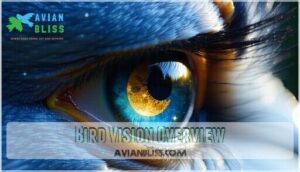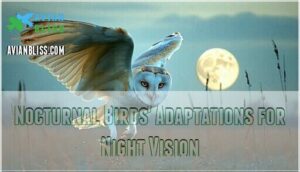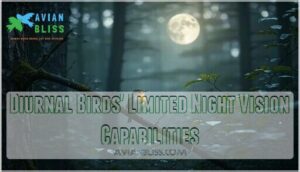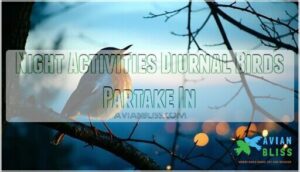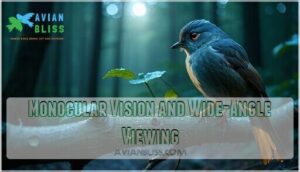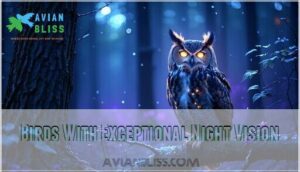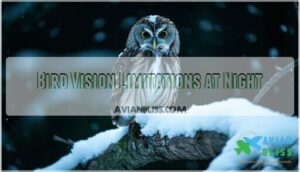This site is supported by our readers. We may earn a commission, at no cost to you, if you purchase through links.
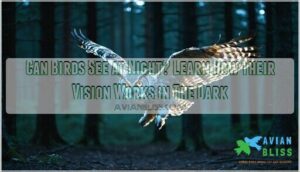
Nocturnal birds like owls are the night vision champions, with specially adapted eyes packed with light-sensitive cells called rods.
They’re like nature’s night-vision goggles! However, your typical daytime birds, such as robins or cardinals, struggle in darkness since their eyes are built for bright daylight hunting and colorful displays.
Think of it this way: nocturnal birds traded crystal-clear daytime vision for superior night sight, while diurnal birds chose the opposite path.
Even the best night-seeing birds can’t function in complete darkness, though. The fascinating world of bird vision reveals surprising adaptations you’d never expect.
Table Of Contents
- Key Takeaways
- Bird Vision Overview
- Can Birds See at Night
- Sight Difference Between Diurnal and Nocturnal Birds
- Night Activities Diurnal Birds Partake In
- Binocular Vs. Monocular Vision in Birds
- Birds With Exceptional Night Vision
- Bird Vision Limitations at Night
- Nocturnal Behavior and Adaptations
- Frequently Asked Questions (FAQs)
- Can birds see in the dark?
- Can birds see at night?
- Do nocturnal birds have night vision?
- How do nocturnal birds see?
- Are birds blind at night?
- Do nocturnal birds see better than diurnal birds?
- Can birds see in the night?
- Do birds have night vision?
- Do birds see better at night?
- Do nocturnal birds see at night?
- Conclusion
Key Takeaways
- You’ll find nocturnal birds like owls have exceptional night vision – they’ve evolved tubular-shaped eyes packed with rod cells, reflective layers called tapetum lucidum, and enlarged pupils that capture maximum light for precise nighttime hunting.
- Most daytime birds can’t see well in darkness – species like robins and cardinals have eyes built for bright daylight with more cone cells than rods, making them struggle significantly once the sun sets.
- Even the best night-vision birds can’t see in complete darkness – they still need some ambient light from the moon, stars, or artificial sources to navigate and hunt effectively.
- Bird vision at night involves fascinating trade-offs – nocturnal species sacrifice crystal-clear daytime color vision and wide fields of view for superior low-light capabilities, while diurnal birds have chosen the opposite evolutionary path.
Bird Vision Overview
When you think about bird vision, it’s far more advanced than ours in many ways.
Birds’ eyes have unique features like a high density of photoreceptors and a broader color range, letting them spot details humans can’t.
Anatomy of a Bird’s Eye
A bird’s eyes are a marvel of nature, finely tuned for incredible vision.
Their large size allows more light intake, essential for sharp vision even in dim settings.
The unique bird eye structure combines efficiency with precision, making birds’ sight extraordinary.
Here’s a breakdown:
- Retina Structure: Packed with rod cells for low light and cones for color.
- Lens Position: Optimized for sharper focus on distant objects.
- Pupil Size: Enlarged pupils capture maximum light.
- Cone Density: Exceptional color detection and UV sensitivity.
- Eye Shape: Curved for broad, detailed vision.
Birds’ eyes are built to dazzle!
Unique Visual Optics of Birds
Four remarkable features make bird eyesight extraordinary compared to human vision.
You’ll find that Tetrachromatic Vision allows birds to see UV, blue, green, and red wavelengths, while UV Sensitivity helps them spot prey and berries from incredible distances.
The Pecten Oculi, a unique structure in bird eye anatomy, supplies nutrients for superior focus.
Oil droplets within cones filter unwanted light, sharpening images like a camera lens.
Magnetoreception acts as their built-in compass, detecting direction and altitude.
Birds also perceive Polarized Light for navigation, while Motion Detection operates at 100Hz—faster than your eyes at 60Hz.
These adaptations create exceptional avian night vision, helping nocturnal species survive in challenging environments.
Can Birds See at Night
You’ve probably wondered if birds can navigate and hunt when darkness falls, and the answer depends entirely on the species you’re observing.
While nocturnal birds like owls possess remarkable night vision adaptations with specialized rod cells and tubular-shaped eyes, most daytime birds struggle substantially in low-light conditions.
Most daytime birds rely on daylight for their daily activities.
Nocturnal Birds’ Vision Capabilities
When darkness falls, nocturnal birds showcase remarkable vision capabilities that put daylight hunters to shame.
Night hunters rule the darkness with vision that makes daytime birds look practically blind.
You’ll find these night specialists use three key adaptations for superior low-light hunting:
- Rod Cell Density: Their retinas pack more light-sensitive rods than cones
- Tubular Eye Shape: Maximizes light-gathering power for enhanced bird night vision
- Tapetum Lucidum: Reflects light back through retinas, boosting avian night vision capabilities
Diurnal Birds’ Limited Night Vision
Most diurnal birds face significant bird vision limitations after sunset.
Their fovea-dependent eyes struggle with navigation difficulties in darkness, creating serious predation risk.
Sleep importance can’t be overstated – these birds sleep night hours to restore energy.
While artificial light provides some help, it disrupts natural patterns.
Unlike nocturnal species, birds awake night hours remain vulnerable due to light sensitivity and poor low-light adaptation.
Structure of Bird Retinas
Your bird’s retina works like a high-tech camera sensor, packed with millions of photoreceptors including rods and cones.
The rod/cone ratio determines light sensitivity – nocturnal species have more rods for night vision.
Retinal layers process visual information efficiently, while fovea density creates sharp focus zones.
Some birds even have UV receptors built into specialized cone cells, making their retina remarkably adaptable.
Function of Photoreceptors, Rods, and Cones
Understanding how bird retinas work feels like looking at nature’s most sophisticated camera system.
Each photoreceptor serves a specific purpose in creating the remarkable vision you see in birds today.
Rod sensitivity allows birds to detect even tiny amounts of light, making twilight hunting possible.
Meanwhile, different cone types handle color detection across multiple wavelengths.
Photoreceptor density varies dramatically between species, with some birds packing nearly twice as many light-detecting cells as humans into each square millimeter.
- Rods: Detect dim light using visual pigments like rhodopsin
- Cones: Process specific colors through specialized light adaptation
- Double cones: Enable movement tracking and polarized light detection
- Oil droplets: Filter light wavelengths for sharper color distinction
- High density: More photoreceptors mean better overall bird vision
UV Vision and Its Importance
While photoreceptors work together to create vision, birds possess something you don’t: the ability to see ultraviolet light.
This UV vision opens up a hidden world that transforms how birds navigate their environment.
Your bird’s eye contains specialized photoreceptors that detect ultraviolet wavelengths, creating what scientists call a tetrachromatic spectrum.
This means birds see four primary colors instead of your three, making their world incredibly vibrant and detailed.
UV vision provides several key advantages that directly impact survival:
| Function | Benefit | Impact |
|---|---|---|
| UV mate selection | Reveals hidden plumage patterns | Guarantees healthier offspring |
| UV prey detection | Spots insects invisible to you | Increases hunting success |
| UV foraging advantage | Identifies ripe berries and fruits | Improves nutrition intake |
This ultraviolet capability also helps with UV egg recognition, allowing parent birds to distinguish their own eggs from those of nest parasites.
Such sophisticated bird vision demonstrates how evolution fine-tuned these remarkable creatures for survival.
Color Perception and Tetrachromacy
Birds possess tetrachromatic vision, meaning they see four primary colors compared to your three.
This tetrachromatic advantage gives them superior color discrimination abilities, especially with UV sensitivity that reveals hidden plumage coloration patterns essential for mate selection.
Key aspects of bird color vision:
- Four types of cone cells detect UV, blue, green, and red light
- Enhanced color perception helps identify ripe fruits and insects
- UV-reflective plumage patterns guide courtship behaviors
- Oil droplets in eyes filter light for sharper color contrast
Motion Detection and Night Vision
Motion-sensing superpowers help nocturnal birds hunt effectively when darkness falls.
You’ll find their rod cell function creates specialized dark circuits that excel at detecting movement in low light conditions.
- Edge detection spots prey outlines against dim backgrounds
- Silhouette vision identifies shapes in near-total darkness
- Movement tracking follows fast insects through shadows
- Light adaptation adjusts quickly to changing darkness levels
Sight Difference Between Diurnal and Nocturnal Birds
You’ll discover that nocturnal birds like owls have tubular-shaped eyes packed with rod cells that capture even the faintest light.
While diurnal birds such as robins have globular eyes filled with cone cells designed for bright daylight vision.
This fundamental difference means night-active birds can hunt and navigate in near darkness, whereas day-active birds struggle to see clearly once the sun sets, highlighting the importance of rod cells.
Nocturnal Birds’ Adaptations for Night Vision
Several remarkable features help nocturnal birds master darkness where you’d struggle to see.
Evolution crafted these night hunters with precision tools that transform complete darkness into their ultimate hunting advantage.
Their tubular eye shape concentrates available light like a telescope, while extraordinary rod cell density creates sharp night vision that puts your eyes to shame.
The tapetum lucidum, a mirror-like layer, bounces light back through their retina for double exposure.
Binocular vision gives owls precise depth perception for low-light hunting, letting them snatch mice you’d never spot.
These bird eye adaptations work together seamlessly, transforming nocturnal birds into nighttime champions through specialized bird vision adaptations that maximize every photon of moonlight for survival.
Diurnal Birds’ Limited Night Vision Capabilities
Day-active species struggle substantially when darkness falls, unlike their nocturnal counterparts.
You’ll notice diurnal birds can’t see well at night because their eyes contain fewer rod cells compared to cone cells.
This bird vision limitation creates serious challenges for bird behavior after sunset.
Diurnal birds face several night vision obstacles that affect their bird vision capabilities:
- Predation Risk increases dramatically in darkness
- Sleep Necessity becomes vital for energy conservation
- Light Sensitivity disrupts natural rest patterns in cities
- Foraging Limitations prevent effective food searching
- Navigation Impairment makes flying dangerous
These bird vision capabilities explain why robins and sparrows stay put once night arrives.
Night Activities Diurnal Birds Partake In
While you might think daytime birds simply sleep once darkness falls, many actually engage in surprising nighttime behaviors despite their limited night vision.
You’ll discover that robins sing at dawn, geese migrate under starlight, and some species perform courtship displays in low-light conditions, all while maneuvering carefully around their visual limitations to engage in surprising activities.
Night Singing and Migration Patterns
Despite lacking exceptional night vision, you’ll find diurnal birds engaging in remarkable after-dark activities.
Urban robins produce nocturnal song under artificial light, confusing their internal clocks and causing sleep deprivation.
Many species undertake bird night migration, using migratory navigation through starlight and magnetic fields.
These birds navigate night skies despite visual limitations, following ancient routes for bird migration.
However, urban noise and light pollution disrupt natural patterns, affecting both bird vision and night singing behaviors and bird vision and night migration success rates substantially.
Nighttime Foraging and Navigation
When darkness falls, you’ll notice diurnal birds face real challenges with nighttime foraging and navigation. Their limited night vision makes prey detection difficult compared to nocturnal specialists.
Light pollution from cities further disrupts their natural sensory adaptations and navigation cues.
Here’s how diurnal birds adapt their foraging strategies at night:
- They rely heavily on moonlight and starlight for basic visibility
- Sound becomes essential for detecting insects and small prey
- They stick to familiar territories where they know food sources
Some bird owners utilize specialized foraging lights to aid their birds.
Sky Dancing and Courtship Behaviors
You’ll witness breathtaking aerial displays when certain birds perform courtship songs and mating rituals after sunset.
Bird dancing becomes spectacular as males execute complex flight patterns, using visual signals for partner selection.
The American Woodcock’s spiraling dives exemplify bird behavior at night, where bird courtship relies on evolved bird vision at night capabilities.
These mesmerizing performances demonstrate how bird mating rituals adapt to darkness, creating nature’s most enchanting nocturnal spectacles.
Binocular Vs. Monocular Vision in Birds
You’ll notice that birds use two different types of vision depending on their hunting needs and lifestyle.
Owls rely on binocular vision, where both eyes focus forward to judge distances precisely when catching prey, while most other birds use monocular vision, positioning their eyes on opposite sides of their heads to watch for predators across a much wider area.
Binocular Vision and Depth Perception
When you watch a hawk dive for prey, you’re seeing binocular vision in action.
This sophisticated system creates overlapping visual fields that enable precise depth perception and remarkable hunting accuracy.
Birds with forward-facing eyes excel at judging distances, making split-second decisions vital for survival.
| Binocular Advantages | Purpose |
|---|---|
| Predator Detection | Spotting threats quickly |
| Distance Judgment | Calculating precise swoops |
| Obstacle Avoidance | Maneuvering through branches |
| Prey Targeting | Capturing small, moving targets |
This bird eye depth perception transforms ordinary hunters into aerial precision machines.
Monocular Vision and Wide-Angle Viewing
Unlike their binocular counterparts, birds with monocular vision sacrifice depth perception for remarkable wide-angle benefits.
You’ll find these birds can scan nearly 360 degrees around them, creating a panoramic view that’s perfect for predator detection.
This bird eye sidefacing design maximizes their bird field of view, though it limits bird depth perception.
The trade-off works brilliantly for survival—peripheral awareness often matters more than precise distance judgment in the wild.
| Vision Feature | Monocular Advantage | Survival Benefit |
|---|---|---|
| Field of View | 300+ degrees | Early predator spotting |
| Peripheral Awareness | Maximum coverage | Multi-directional monitoring |
| Eye Positioning | Side-facing placement | Continuous surveillance |
| Scanning Ability | Rapid head movements | Quick threat assessment |
| Detection Range | Wide-angle monitoring | Enhanced safety zone |
Birds With Exceptional Night Vision
You’ll discover that certain bird species possess remarkable night vision abilities that far exceed what most daytime birds can achieve in darkness.
These exceptional nocturnal hunters, including owls, nightjars, and potoos, have evolved specialized eye structures with high concentrations of rod cells and unique adaptations like tubular-shaped eyeballs that maximize light capture for precise nighttime navigation and hunting.
Owls’ Superior Night Vision Capabilities
Owls dominate nighttime hunting because their owl eye shape creates a biological advantage that’s hard to beat. Their tubular eyes work like telescopes, concentrating available light into razor-sharp images. You’ll notice their massive pupils can dilate to capture every photon, while their incredible rod cell density detects movement in near-total darkness.
Owls’ specialized anatomy transforms them into living night-vision goggles, making darkness their hunting advantage.
These remarkable hunters rely on several key adaptations:
- Binocular vision provides precise depth perception for accurate strikes
- Tapetum lucidum reflects light back through the retina, amplifying available illumination
- Fixed tubular eyes require 270-degree head rotation for complete visual coverage
- Silent flight feathers eliminate sound, ensuring undetected approaches
Their owl night vision surpasses most nocturnal creatures because evolution perfected their bird vision anatomy for darkness. Combined with their stealth hunting strategies, owls become nearly unstoppable predators when the sun sets.
Nocturnal Birds’ Adaptations for Night Hunting
Specialized nocturnal birds have perfected birds hunting night through remarkable bird adaptations.
Their tubular eyes packed with high rod density capture minimal light, while the tapetum lucidum reflects it back for enhanced night vision.
Silent flight feathers muffle wing beats, letting them approach prey undetected.
The binocular advantage provides precise depth perception for accurate strikes.
Owl night vision exemplifies these features perfectly—huge eyes, offset ears for sound triangulation, and comb-like wing edges eliminate hunting noise, making them unstoppable nighttime predators.
Bird Vision Limitations at Night
You’ll discover that even birds with excellent night vision face significant challenges when darkness falls, as their visual systems can’t overcome certain physical limitations.
Most birds struggle with reduced color perception, decreased visual sharpness, and difficulty spotting objects at greater distances when light levels drop below their ideal range, which is a challenge related to their visual systems.
Visual Acuity and Distance Limitations
Even the sharpest-eyed birds struggle with distance perception when darkness falls.
Your feathered friends face significant acuity thresholds that make judging distances tricky in low light conditions.
Bird vision in low light creates a limited range for detecting objects, affecting their night foraging and predator avoidance abilities.
- Light sensitivity reduces their ability to spot obstacles at safe distances
- Distance perception becomes unreliable beyond a few feet in darkness
- Obstacle avoidance requires birds to fly closer to navigate safely
Color Vision and Low Light Limitations
When darkness falls, you’ll notice bird vision transforms dramatically.
Color perception fades as cone density drops and tetrachromacy limits kick in.
UV sensitivity vanishes almost completely, leaving birds seeing a muted world.
The fovea performance plummets in low light vision, making sharp color detection nearly impossible.
Bird eye cones simply can’t function without adequate light.
Aspect Daylight Vision Night Vision
Blind Spots and Visual Obstructions
Beyond color perception challenges, nocturnal birds must navigate through blind spots that create real hazards during nighttime flights.
Their Limited Field of vision means they can’t see everything at once, creating dangerous gaps in awareness. Feather Obstructions around their eyes can block peripheral vision, while Environmental Obstacles like branches and power lines pose constant threats in builtup areas.
- Partial Blindness: Birds compensate for visual gaps through rapid head movements and enhanced edge detection
- Urban environments: City structures create complex obstacle courses that challenge even skilled night fliers
- Obstruction Compensation: Enhanced silhouette detection helps birds identify threats despite visual limitations
Nocturnal Behavior and Adaptations
You’ll discover that nocturnal birds have developed remarkable survival strategies that go far beyond their exceptional night vision.
These specialized adaptations, including moonlight navigation, echolocation abilities, and sensitive whisker-like feathers, allow night-active species to thrive in complete darkness when most other birds can’t function effectively, utilizing their exceptional night vision.
Moonlight and Starlight Navigation
When darkness falls, you’d think birds would struggle to find their way, but they’ve mastered lunar orientation and stellar compass navigation like ancient mariners.
These celestial cues act as their built-in GPS during nighttime migration, helping birds maintain precise flight paths across vast distances. Moonlight enhances their natural light sensitivity, while star patterns provide reliable reference points.
However, light pollution increasingly disrupts these navigation systems, forcing birds to adapt their traditional routes. Some researchers study specifics of bird navigation to understand these adaptations.
Here’s how birds use celestial navigation:
Can birds see stars? Absolutely—their enhanced bird vision allows them to detect even faint celestial markers that guide their incredible journeys.
Echolocation and Sound Waves
When you’re exploring bird navigation at night, you’ll discover that sound wave navigation complements bird vision beautifully.
True bird echolocation occurs in just two species – oilbirds and swiftlets – who use rapid clicks for obstacle detection sounds in dark caves. These bird echolocation types involve short, sharp calls that bounce back, creating detailed maps.
Most birds rely on exceptional hearing instead. Owls use asymmetrical ears for precise bird sensory perception, while various bird calls help with navigation when bird vision fails completely.
Specialized devices aid echolocation in some research settings.
Whisker-Like Feathers and Sensing
Nocturnal birds possess remarkable whisker-like feathers called rictal bristles that function as sophisticated sensory tools.
These specialized sensory bristles around their beaks detect minute air currents and vibrations, enhancing bird sensory perception during nighttime hunts.
Through feather tactility and feather vibration, these adaptations complement their exceptional vision.
Here’s how these bird anatomy features work:
- Spatial awareness increases through detecting airflow changes around obstacles
- Prey detection improves by sensing movement vibrations in surrounding air
- Environmental navigation becomes easier with enhanced tactile feedback
- Bird nocturnal predators gain hunting advantages through combined sensory input
This bird adaptation showcases nature’s ingenious bird physiology solutions for nighttime survival.
Frequently Asked Questions (FAQs)
Can birds see in the dark?
Like tiny night-vision goggles, most birds can see in dim light but not complete darkness. You’ll find nocturnal species like owls have special adaptations, while daytime birds struggle without light.
Can birds see at night?
Most birds can see at night, but not in complete darkness. Nocturnal species like owls have exceptional night vision with specialized eyes, while day-active birds have limited nighttime sight capabilities.
Do nocturnal birds have night vision?
Night hunters possess eyes like biological telescopes, perfectly tuned for darkness.
You’ll find they’ve specialized rod cells, tubular eyeballs, and reflective layers that amplify moonlight, giving them extraordinary vision when daylight fades away.
How do nocturnal birds see?
You’ll find these night hunters use specialized eyes with tubular shapes and extra rod cells.
Their pupils dilate wide, letting in maximum light, while a reflective layer called tapetum lucidum bounces light back through their retinas.
Are birds blind at night?
No, birds aren’t completely blind at night.
Most species have limited night vision compared to owls and other nocturnal birds.
They can detect movement and basic shapes in moonlight but struggle in total darkness.
Do nocturnal birds see better than diurnal birds?
Think of night vision as nature’s spotlight – nocturnal birds absolutely see better than diurnal birds in darkness.
You’ll find owls and nighthawks have specialized rod-packed eyes, while day birds struggle once the sun sets, and this is due to their nocturnal abilities.
Can birds see in the night?
Yes, you’ll find that birds can see at night, though not in complete darkness.
Nocturnal species like owls have specialized adaptations with more rod cells, while diurnal birds have limited nighttime vision capabilities.
Do birds have night vision?
While you might think all birds are blind after sunset, most actually have decent night vision.
They can’t see in total darkness, but their large pupils and rod-rich eyes help them navigate dim conditions.
Do birds see better at night?
Most birds don’t see better at night than you do. Nocturnal species like owls have specialized adaptations with more rod cells, but they can’t see in complete darkness either.
Do nocturnal birds see at night?
Nocturnal birds absolutely see at night.
You’ll find they’ve evolved specialized eyes with more rod cells, tubular shapes, and reflective layers that amplify available light.
Making them expert nighttime hunters and navigators.
Conclusion
Nature’s vision toolkit reveals that can birds see at night depends entirely on their lifestyle choices.
Like switching between sunglasses and night-vision goggles, birds have evolved specialized eyes for their hunting schedules.
Owls dominate darkness with rod-packed retinas, while songbirds stumble through shadows.
You’ve discovered how these feathered creatures navigate their world through remarkable adaptations.
Whether they’re nocturnal hunters or daytime singers, each species has perfectly matched their vision to their survival needs.
- https://www.birdfy.com/blogs/blogs/bird-vision-explained-what-makes-it-so-unique?srsltid=AfmBOooI7XtBNOijCiVhQ-3aQ3qe1yYYXRV6cxtqkQlRI5irzBAOFdsx
- https://www.woofpurnayvet.com.au/blog/2022/2/28/can-my-pet-see-in-the-dark
- https://en.wikipedia.org/wiki/Bird_vision
- https://www.birdwatchersgeneralstore.com/can-birds-see-in-the-dark/
- https://www.quora.com/Do-birds-see-in-the-dark-What-does-this-mean-for-humans-and-owls-if-we-ever-cross-paths-with-them-at-night

